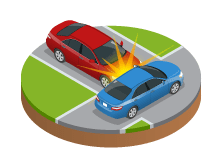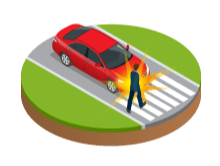Get the cheapest quotes for your car
Compare providers in your area.
Your information is secure
Compare providers in your area.
Your information is secure
West Virginia drivers pay an average of $1,096.80 per year for car insurance according to the National Association of Insurance Commissioners (NAIC), that’s about $91.40 per month. West Virginia drivers pay about 8% less than the countrywide national average of $1,189.64.
The NAIC takes into account all car insurance policies within the state such as drivers who select only state minimum coverage, as well as policies that include various levels of comprehensive and collision coverage. Because car insurance rates are influenced by personal factors, you could find yourself paying significantly less.

In at-fault states, the driver who caused the accident pays for damages.
Drivers in West Virginia are required to carry a minimum amount of liability coverage to legally drive. You may see it written as 25/50/25, but we’ll break down what that means.

West Virginia requires $25,000 in bodily injury liability per person and $50,000 of bodily injury per accident. That’s right in line with what most states require for this type of coverage.
This means $25,000 is the most your insurer will pay for a single person injured by you in an at-fault accident. And $50,000 is the maximum amount your insurer will pay if there is more than one person injured by you in an at-fault accident. Any costs outside of your bodily injury limit are required to come out of your pocket.

West Virginia requires drivers to carry $25,000 of property damage liability to legally drive. This is the highest required property damage limit across the US, but it’s common among states.
This means $25,000 is the maximum amount your car insurance company will pay towards damages you cause to another person’s car or property, such as repairs to a car, fence or building. You’ll have to pay out of pocket for any costs beyond your property damage liability limit.

West Virginia requires all drivers to carry $25,000 of uninsured motorist bodily injury per person, $50,000 uninsured motorist bodily injury per accident and $25,000 in uninsured motorist property damage to legally drive. Near half of the states across the US require some sort of uninsured motorist coverage, though some other states let you opt-out.
This coverage protects you if you get hit by an uninsured or underinsured driver. It pays for your car’s damage or medical bills to you and your passengers.
These state-mandated requirements are the lowest amount of coverage you need to legally drive in West Virginia, but may fall short if you’re in a major accident. To avoid high out-of-pocket costs after an accident, consider raising your liability limits by balancing coverage, your budget and what you can afford to pay out of pocket for certain damage.
West Virginia is an at-fault state, which means that the driver who causes the car accident pays for the damage. Your insurance company and legal authorities will figure out who’s at fault, based on the accident details.
However, West Virginia also looks at whether both drivers are partially at fault under a modified comparative fault law, according to the legal website Nolo. Under this law, both drivers are assigned a percentage of fault. Drivers with less than 50% of fault can get reimbursed for their damages from other drivers.
For example, if you’re 80% at fault for an accident, your insurance will pay 80% of the other driver’s damages. However, since you’re more than 50% at fault, the other driver isn’t required to pay for your damages.
You’ll want a quote from Allstate if you’re a young driver under age 25 who wants to pay sub-$200 per month for car insurance.
However, the cheapest company jumps around for other ages. Get quotes from all of these insurance companies to make sure you’re getting the best deal.
| Age | Allstate | Progressive | Geico | USAA |
|---|---|---|---|---|
16-24 | $161.57 | $214.47 | $203.28 | – |
25-34 | $151.52 | $155.90 | $139.87 | $126.27 |
35-44 | $95.54 | $146.00 | $128.25 | $154.34 |
45-54 | $142.23 | $136.04 | $144.87 | – |
In this sample, USAA brings the cheapest rates for men above competitors. However, women may find the best deal with Allstate, paying more for car insurance than men overall.
| Company | Allstate | Progressive | Geico | USAA |
|---|---|---|---|---|
Men | $111.50 | $171.75 | $141.35 | $91.77 |
Women | $126.09 | $163.38 | $147.62 | $157.56 |
Shopping around is paramount to getting the best deal in West Virginia. For example, you’ll see a $45 difference between Allstate and Progressive. We base this cost information on sample quotes from Savvy.
| Company | Allstate | Progressive | Geico | USAA |
|---|---|---|---|---|
Rate | $121.92 | $166.97 | $143.96 | $135.63 |
Car insurance companies use factors specific to you to set how much you’ll pay for car insurance. The less risk in each of your factors means you’ll pay less, whereas higher risk factors mean you’ll pay more. We break down West Virginian’s rating factors to keep in mind.
| Factor | How it affects your rates |
|---|---|
Age | Driver age is one of the top factors when determining car insurance rates. Each year you drive gives you more experience that can equal lower rates. The average annual rates for a 25-year-old man are approximately $1,450 vs. $1,100 for their 60-year-old counterpart. |
Gender | Studies have shown that women statistically drive less, experience fewer and less serious accidents, and get charged fewer DUIs than men. This results in women paying less than men for their annual car insurance. For example, a 25-year old woman can expect to pay an average annual rate of around $1,390 compared to a man of the same age category, who pays around $1,450. In the 60-year-old category, women can pay approximately $1,070 annually vs. $1,100 for men. |
Location | Living in less densely populated areas can account for lower insurance rates. For example, the largest city is Charleston with a population of approximately 46,500 and average car insurance rates of $1,210. In contrast, West Virginia’s smallest city of Martinsburg with around 17,400 people sees average yearly car insurance rates of $1,050. |
Vehicle and mileage | Your vehicle’s make, model and trim package all affect your insurance rates. Add any aftermarket and performance-enhancing modifications, and your rates will be even higher. Considerations like the chances of your car getting stolen, your model’s safety rating and its overall cost also make a difference. Cheaper, safer vehicles score the lowest rates compared to luxury, high-powered rides. Typically, insurance companies use your mileage to help determine your car insurance rates. If you drive around 6,000 miles annually, expect an average rate of $1,180. Double that mileage to 12,000 miles a year and you’ll see your rates climb to about $1,230. |
Credit score | Insurance companies use drivers’ credit scores to help calculate a car insurance rate. Low credit scores in West Virginia will set you back more than $800 annually over those with good credit. Annual rates for those with low credit average out to about $2,070 vs. those with good credit at approximately $1,230. |
Coverage | Drivers in West Virginia must have coverage for the minimum liability limits. Drivers must also have the same liability coverage for uninsured drivers in the same amounts as the minimum. These limits work out to 25/50/25 for each. More coverage means more protection — and higher monthly premiums. But if you choose full coverage with collision and comprehensive, your deductible also comes into play: The higher your deductible, the lower your monthly premiums will be. If full coverage is feasible, it can provide you peace of mind in the event of an accident. |
Driving Record | Your driving record will reflect the level of your car insurance rates. Average rates for drivers with a clean record come out to about $1,230, and rates for drivers with one accident rank around $1,470. Contrast those prices with records that have one accident at $1,710, and one DUI at $1,870, respectively. |
No, West Virginia is one of the few states that doesn’t require you to file an SR-22 if you have serious driving violations on your record. In most states, if you’re caught driving and driving, have too many speeding tickets, or are found driving without insurance, the state lets you know if you need to file an SR-22 to get your license back. It’s a certificate that proves you have enough coverage to meet your state’s minimum insurance requirements. However, if you move to West Virginia from another state that required you to file an SR-22, you probably need to continue meeting your SR-22 insurance requirements while in West Virginia.
West Virginia already has decent minimum requirements for insurance. But if you want some extra coverage for yourself, we have some suggestions.
West Virginia requires you to carry $25,000 bodily injury liability per person, $50,000 bodily injury per accident, and uninsured motorist coverage – which is all great. But what about events not involving a car accident? That’s where comprehensive coverage comes in. It can cover your vehicle in the event of a storm or water damage, falling objects, hitting an animal, fire, theft, and more.
West Virginia has a 127.2 vehicle theft rate per 100,000 inhabitants, which is low compared to the average, reported by Statista. However, if your car is stolen and never recovered and you don’t carry comprehensive insurance you’d be left to replace your vehicle on your own. Additionally, weather damage or flooding can devastate a car, as well as your wallet. Look into comprehensive coverage if you heavily rely on your vehicle day to day.
Consider comprehensive coverage if . . .
Gap insurance covers the “gap” between what you owe on your car loan and your vehicle’s value. Gap stands for guaranteed asset protection. If you were to get into an accident that totals the car or it’s stolen and never recovered, regular auto insurance only pays out what your vehicle’s value was at the time of the event. If you owe more on your auto loan than what your car’s worth, then you’re not likely to get a big enough payout from your insurance company to pay off your car loan. This can be a big pain, because then you still have to pay for a loan on a vehicle you can’t drive or don’t have anymore.
For drivers that have expensive auto loans and/or brand new vehicles, gap insurance can be worth it. It’s relatively inexpensive too, often only costing $20 a year or around $2 a month. It’s also common for leasing companies to require this insurance in addition to full coverage.
Consider gap insurance if . . .
Health coverage can be pricey for many people. If you have high copays and/or deductibles, or you don’t have health insurance at all, then medical payments coverage may be worth looking into. Also called med pay, this coverage can help you pay for medical costs after a vehicle accident. It can cover things likes ambulance rides, hospital stays, and even help pay for your passenger’s medical costs.
Consider medical payments coverage if . . .
We’ve pulled the top 10 companies by market share that offer coverage in West Virginia according to S&P Global. Compare top companies by three major rating agencies along with our overall score.
| Provider | BBB Rating | JD Power Rating | NAIC complaint ratio | National market share % | Finder score | Go to site |
|---|---|---|---|---|---|---|
A+ | 847/1000 | 1.93 | 16.2 | ★★★★★ 4/5 | ||
A+ | 832/1000 | 1.42 | 13.6 | ★★★★★ 4/5 | ||
A+ | 830/1000 | 1.05 | 13.3 | ★★★★★ 4/5 | ||
A+ | 827/1000 | 2.71 | 10.4 | ★★★★★ 4/5 | ||
A+ | 884/1000 | 1.9 | 6.3 | ★★★★★ 4/5 | ||
A- | 820/1000 | 1.64 | 4.9 | ★★★★★ 4/5 | ||
A+ | 827/1000 | 2.2 | 4.7 | ★★★★★ 4/5 ; | ||
A+ | 814/1000 | 2.08 | 2.3 | ★★★★★ 4/5 | ||
A+ | NR | NR | 1.4 | ★★★★★ 4/5 | ||
A+ | 833/1000 | NR | 0.7 | ★★★★★ 3.5/5 |
Of West Virginia’s largest cities, Morgantown has the cheapest rates and Princeton has the most expensive car insurance rates. Princeton drivers could face rates 2 times more than Morgantown drivers.
Company | Annual car insurance rate |
|---|---|
| Allstate | $1950 |
| Metromile | $1225 |
| Progressive | $2179 |
| Geico | $2283 |
| StateFarm | $1425 |
Company | Annual car insurance rate |
|---|---|
| Allstate | $2126 |
| Metromile | $1146 |
| Progressive | $2376 |
| Geico | $2408 |
| StateFarm | $1529 |
Company | Annual car insurance rate |
|---|---|
| Allstate | $2126 |
| Metromile | $1188 |
| Progressive | $2475 |
| Geico | $2221 |
| StateFarm | $1461 |
Company | Annual car insurance rate |
|---|---|
| Allstate | $2084 |
| Metromile | $1110 |
| Progressive | $2406 |
| Geico | $2879 |
| StateFarm | $1611 |
Company | Annual car insurance rate |
|---|---|
| Allstate | $2158 |
| Metromile | $1223 |
| Progressive | $2273 |
| Geico | $2408 |
| StateFarm | $1559 |
The right car insurance policy can help protect you, your vehicle and other motorists on the road. And in the state of West Virginia, you’re legally required to maintain coverage if you want to drive. Compare the laws and requirements in your state to find the best value on your car insurance coverage.
Some of the top auto insurance providers for single moms and dads to save on options without dropping coverage.
Purchase basic to premium plans for car-sharing. Take home more pay the less Turo covers.
Some of the top auto insurance providers that offer coverage for gig workers who use their cars for work.
Cheap car insurance options for teen drivers.
Receive extra liability coverage with an umbrella policy from these top insurers, though they may require you to have car insurance through them.
If you’re a teacher or work in the education field, you can find special rates and discounts on your car insurance.
Find the cheapest car insurance companies if you’re a military member or veteran, and find ways to save on military car insurance.
Compare cheap car insurance coverage in Mississippi.
Compare the best short term car insurance policies for monthly, six-month and temporary car insurance coverage.
Compare the best car insurance in one place.